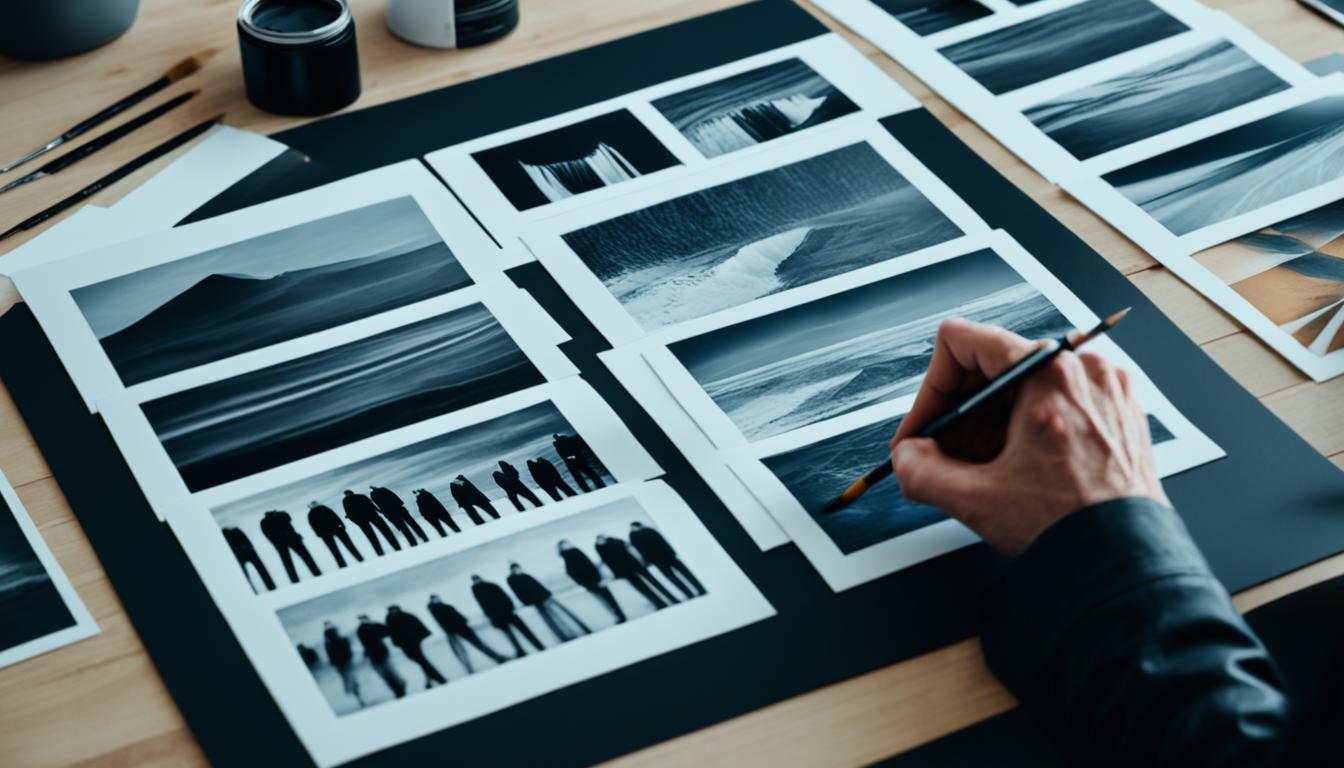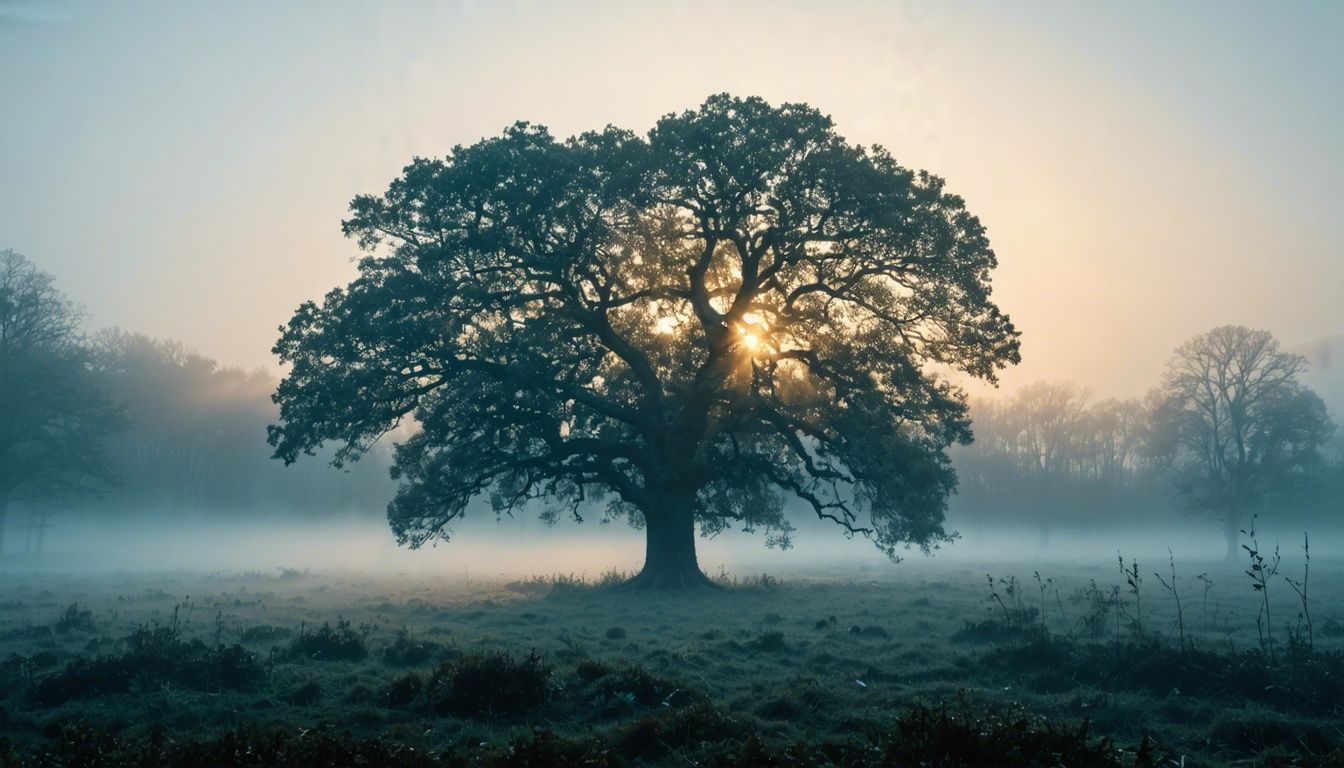A well-crafted portfolio is essential for any aspiring or professional fine art photographer. It not only showcases your best work but also tells a story and captures your unique artistic vision. In this comprehensive guide, we will explore the key steps to building a portfolio that impresses any audience and helps you achieve your artistic goals.
Key Takeaways:
- Building a portfolio is crucial for fine art photographers to showcase their best work and artistic vision.
- Clarify your artistic goals and identify your target audience before starting the portfolio creation process.
- Select your strongest pieces of art that best represent your style and skills for your portfolio’s contents.
- Presentation is key – choose high-quality materials for physical portfolios and optimize your website for online portfolios.
- Experiment with different mediums and techniques to add diversity and captivate your audience.
Clarify your Artistic Goals
Before embarking on the process of portfolio development for artists, it is crucial to clarify your artistic goals. This step sets the foundation for building a fine art photography showcase that resonates with your target audience and showcases your unique vision. By clarifying your goals, you can ensure that your portfolio is a true reflection of your artistic identity and effectively communicates your creative message.
To begin, take the time to carefully write down what you want to achieve as an artist. Consider the themes, subjects, and styles that interest you the most. Ask yourself questions like, “What emotions do I want my art to evoke?” or “What stories do I want to tell?” By exploring these aspects, you can gain a deeper understanding of your artistic vision.
Next, identify your target audience. Think about the people who are most likely to appreciate and connect with your artwork. Consider their preferences, values, and interests. This knowledge will help you tailor your photography portfolio to effectively engage and captivate your desired audience.
“Clarity of goals is essential for building a successful photography portfolio. It anchors your artistic journey and enables you to curate a collection of images that reflect your unique perspective.” – Rachel Foster, Fine Art Photographer
By clarifying your artistic goals and understanding your target audience, you lay a solid foundation for building a photography portfolio that showcases your talent and resonates with others. So take the time to reflect on your aspirations and the audience you want to engage, and let them guide your portfolio development process.
Prepare Your Portfolio’s Contents
Once you have a clear understanding of your goals and audience, it’s time to curate your portfolio’s contents. As photographers, we know that selecting the right images is crucial to showcasing our skills and artistic vision. Here are some tips to help you create a compelling and impactful photography portfolio:
1. Choose Your Strongest Pieces
Review your body of work and identify the images that best represent your style, creativity, and technical proficiency. Look for photographs that evoke emotions and tell a story. Remember, quality is more important than quantity. It’s better to showcase a smaller number of exceptional images than to overwhelm your audience with mediocre ones.
2. Seek Outside Opinions
Don’t underestimate the power of constructive feedback. Share your portfolio with trusted peers, mentors, or fellow photographers whose opinions you value. Their fresh perspective can provide valuable insights and help you identify any blind spots or areas for improvement. Consider their feedback carefully and make revisions accordingly.
3. Limit the Number of Images
While it’s important to include enough images to showcase your range and versatility, it’s equally crucial to avoid overwhelming your audience with too many photographs. A portfolio with around 10 to 20 carefully selected images is often sufficient to make a strong impression and leave viewers wanting more.
When choosing the images for your portfolio, aim for a cohesive and diverse collection that highlights your skills across different genres, techniques, or subjects. Show your versatility while remaining true to your artistic voice.
4. Organize Your Portfolio Thoughtfully
Consider the flow and narrative of your portfolio. Arrange your images in a logical and engaging sequence that tells a story or highlights your artistic progression. Pay attention to composition, color schemes, and visual harmony between images. Create a seamless viewing experience that captivates your audience from start to finish.
5. Add Context and Descriptions
Help your viewers understand the inspiration, concept, or story behind each image by providing brief descriptions or captions. These details can enhance the viewer’s understanding and appreciation of your work, allowing them to connect with your art on a deeper level.
“A photograph is worth a thousand words, but sometimes a few well-chosen words can elevate it to a whole new level.” – Unknown
By taking the time to carefully curate your photography portfolio, you can create a visually stunning and cohesive body of work that effectively communicates your unique artistic vision and leaves a lasting impression on viewers.
| Benefits of Preparing Your Portfolio’s Contents | Considerations |
|---|---|
| 1. Showcasing your best work | 1. Quality over quantity |
| 2. Making a memorable impression | 2. Seeking constructive feedback |
| 3. Highlighting your versatility | 3. Balancing the number of images |
| 4. Creating a cohesive narrative | 4. Organizing images thoughtfully |
| 5. Engaging viewers on a deeper level | 5. Adding context and descriptions |
Fine Tune Your Portfolio’s Presentation
When it comes to building a photography portfolio, the presentation is everything. Whether you’re showcasing your work in a physical portfolio or online, the way you present your photographs can make a significant impact on how they are perceived by your audience. To ensure your portfolio stands out from the crowd, here are some key tips for fine-tuning its presentation:
For Physical Portfolios:
- Choose High-Quality Materials: Invest in a portfolio case or album that is durable, well-crafted, and visually appealing. Opt for materials that enhance the overall aesthetic of your work.
- Keep the Design Simple: Avoid overcrowding your physical portfolio with too many photographs or unnecessary elements. Let your work take center stage by opting for a clean and minimalist design.
“Simplicity is the ultimate sophistication.” – Leonardo da Vinci
For Online Portfolios:
- Research Web Platforms: Explore different website builders or platforms specifically designed for photographers to showcase their portfolios. Look for user-friendly interfaces, customizable templates, and responsive designs.
- Optimize User Experience: Ensure your online portfolio is easy to navigate, with intuitive menus and clear labeling. Consider the user experience from both desktop and mobile perspectives.
- Compress Images: Optimize your photographs for web display by compressing them without compromising their quality. This will improve loading times and ensure a seamless browsing experience for viewers.
- Choose a Professional Website Name: Select a domain name that reflects your brand and resonates with your target audience. It should be memorable, relevant, and easy to spell.
To illustrate the importance of presentation in portfolio building for photographers, take a look at the following example:
| Photographer A | Photographer B |
|---|---|
 |
 |
| Physical Portfolio | Online Portfolio |
| Uses a premium leather-bound portfolio case and high-quality prints. The design is clean and minimal, allowing the photographs to speak for themselves. | Optimized website with a user-friendly interface and fast loading times. The portfolio showcases images in an organized and visually appealing manner. |
As you can see from the example above, both the physical and online portfolios are presented in a way that emphasizes the photographers’ skills and artistic vision. Remember, a strong presentation can elevate your work and leave a lasting impression on potential clients or collaborators.
Experiment Across Different Mediums and Techniques
Creating a fine art portfolio is not only about showcasing your best work, but also about demonstrating diversity and pushing the boundaries of your artistic expression. By experimenting with different mediums and techniques, you can bring a fresh perspective to your portfolio and captivate your audience with unique and engaging artwork.
Stepping out of your comfort zone is crucial in developing your artistic style and expanding your skills. Embrace the opportunity to explore new mediums such as painting, sculpture, mixed media, or digital art. Each medium offers its own set of challenges and opportunities for creativity.
Moreover, don’t be afraid to challenge traditional techniques and push the boundaries of what is considered “normal” in the art world. Experiment with unconventional materials, experiment with different brush strokes, or explore alternative printing techniques. By pushing the limits, you can create artwork that stands out and captures the attention of viewers.
Including works that showcase your creative voice and provoke emotions is key to building an impactful portfolio. Let your artwork speak for itself and convey your unique perspective to the viewer. Whether it’s through compelling subject matter, vivid colors, or thought-provoking compositions, aim to evoke a strong emotional response with every piece.
Providing good documentation and adding context to your artwork can enhance the viewer’s understanding and appreciation of your portfolio. Share the inspiration behind each piece, the techniques utilized, and any relevant stories or anecdotes that add depth to your artwork. These details help create a personal connection between the viewer and your art, making your portfolio more memorable.
In summary, creating a fine art portfolio involves experimenting with different mediums and techniques, showcasing your creative voice, and providing context for your artwork. By incorporating these elements into your portfolio, you’ll create a diverse and captivating collection that represents your unique artistic journey.
| Benefits of Experimenting Across Mediums and Techniques | Examples |
|---|---|
| 1. Enhanced artistic growth and exploration | Creating a series of paintings that complement your photography portfolio |
| 2. Increased audience engagement and interest | Combining photography with digital manipulation to create surreal compositions |
| 3. Unique and diverse portfolio that stands out | Experimenting with alternative printing techniques, such as cyanotype or photogravure |
| 4. Increased marketability and opportunities | Exploring sculpture and installation art alongside your photography work |
Venturing into Fine Art Photography
Fine art photography is a captivating genre that requires a mastery of technique and a strong artistic vision. To excel in this field and build a successful portfolio, there are several key elements to consider.
Invest in Quality Equipment
High-quality equipment plays a crucial role in capturing the essence of fine art photography. A camera with excellent resolution and dynamic range will allow you to capture intricate details and vibrant colors. Additionally, invest in high-quality lenses that can bring out the best in your subjects and compositions.
“Investing in good equipment is vital to achieving the desired quality in your fine art photography.”
Pay Attention to Lighting and Composition
Lighting and composition are fundamental aspects of fine art photography. Experiment with different lighting techniques to create mood and drama in your images. Understanding the principles of composition, such as the rule of thirds and leading lines, will help you create visually compelling photographs.
Choose Models and Subjects Carefully
Select models and subjects that align with your artistic vision. Look for individuals who can bring a unique story or emotion to your photographs. By carefully choosing your subjects, you can create powerful and thought-provoking images that resonate with your audience.
Consider Post-Production Techniques
Post-production is an essential part of fine art photography. Use editing software to enhance your images, emphasizing specific elements or creating a desired mood. Experiment with different techniques, such as color grading or adding texture, to bring your artistic vision to life.
Explore Different Genres
Don’t be afraid to explore various genres within fine art photography. Experiment with landscape photography, still life, portraits, or abstract photography. Exploring different genres will not only expand your technical skills but also provide diversity in your portfolio, showcasing your versatility as a fine art photographer.
By considering these tips and techniques, you can venture into the world of fine art photography and build a captivating portfolio that represents your unique vision and creative voice.

Sample Portfolio Genre Diversification
| Genre | Description |
|---|---|
| Landscape Photography | Showcases the beauty of nature, capturing stunning landscapes and breathtaking sceneries. |
| Abstract Photography | Explores the use of shapes, lines, and colors to create visually striking and thought-provoking images. |
| Portraiture | Captures the essence of individuals, conveying their emotions and unique stories through powerful portraits. |
| Still Life Photography | Focuses on inanimate objects, arranging them in a visually pleasing manner to create artistic compositions. |
Conclusion
Building a fine art photography business starts with a strong portfolio that showcases your unique artistic vision. By clarifying your objectives and understanding your target audience, you can curate a collection of your best work that leaves a lasting impression.
Remember to continuously refine and update your portfolio as your artistic journey evolves. Experimenting with different mediums and techniques can bring diversity and captivate your audience. Consider venturing into fine art photography, investing in high-quality equipment, and perfecting your skills to expand your portfolio.
With passion and determination, a well-crafted portfolio can be the key to embarking on a successful career in the world of fine art photography. So, present your work effectively, tell your story, and let your art shine.
FAQ
Why is building a portfolio important for fine art photography?
Building a portfolio is essential for any fine art photographer as it showcases your best work, tells a story, and captures your unique artistic vision. It is a vital tool in impressing audiences and achieving your artistic goals.
How do I clarify my artistic goals?
Start by writing down exactly what you want to achieve as an artist and identify your target audience. Consider their preferences and values to tailor your portfolio accordingly.
How many images should I include in my portfolio?
Limit the number of images to no less than ten and no more than twenty. Be selective and choose your strongest pieces of art that best represent your style and skills.
What should I consider when presenting my portfolio physically?
For physical portfolios, choose high-quality materials and keep the design simple to let your work shine. Pay attention to details like lighting and composition when documenting your artwork.
How do I optimize my online portfolio?
Research different web platforms and optimize your website for an optimal user experience. Compress images for faster loading times and choose a professional website name to enhance your online presence.
How can I make my portfolio more diverse and captivating?
Experiment with different mediums and techniques to showcase your creative voice. Step out of your comfort zone and express your unique perspective. Provide good documentation and add context to complement your artwork.
What should I focus on in fine art photography?
Fine art photography requires mastery of technique and a strong artistic vision. Invest in high-quality equipment, pay attention to details like lighting and composition, and explore different genres of fine art photography to expand your skills and portfolio.
What should I do after building my portfolio?
Always refine and update your portfolio as your artistic journey evolves. Continuous improvement and adaptability are key in achieving a successful career in fine art photography.
How Can I Use Fine Art Grants to Build My Photography Portfolio?
Photographers seeking to enhance their portfolios can tap into the world of fine art grants to expand their opportunities. By applying for and securing these grants, aspiring photographers can access the necessary funds to develop their artistry and explore fine art funding opportunities. With financial support, photographers can invest in equipment, travel, and education necessary to refine their craft and showcase their unique perspectives to a wider audience.




